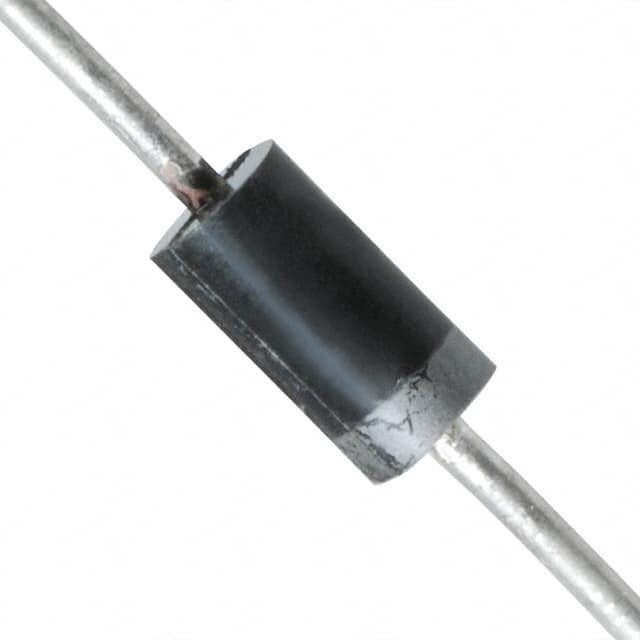1N4752A-TP: Semiconductor Diode
Basic Information Overview
- Category: Semiconductor Diode
- Use: Voltage Regulation
- Characteristics: Zener Diode, 33V, 1W
- Package: DO-41
- Essence: Regulates voltage in electronic circuits
- Packaging/Quantity: Bulk or Tape & Reel
Specifications
- Voltage: 33V
- Power Dissipation: 1W
- Zener Voltage Tolerance: ±5%
- Operating Temperature Range: -65°C to +200°C
- Storage Temperature Range: -65°C to +200°C
Detailed Pin Configuration
The 1N4752A-TP is a two-terminal device with anode and cathode pins. The anode is marked with a band on the body of the diode.
Functional Features
- Provides stable voltage regulation
- Protects sensitive components from voltage spikes
- Can be used in reverse-bias mode for voltage reference applications
Advantages and Disadvantages
Advantages
- Precise voltage regulation
- Compact size
- Wide operating temperature range
Disadvantages
- Limited power dissipation capability
- Susceptible to damage from excessive current or voltage
Working Principles
The 1N4752A-TP operates based on the Zener effect, where it maintains a nearly constant voltage across its terminals when reverse-biased at its specified breakdown voltage.
Detailed Application Field Plans
The 1N4752A-TP is commonly used in: - Voltage regulators - Power supplies - Overvoltage protection circuits - Signal clamping circuits
Detailed and Complete Alternative Models
- 1N4748A-TP (22V, 1W)
- 1N4749A-TP (24V, 1W)
- 1N4750A-TP (27V, 1W)
- 1N4751A-TP (30V, 1W)
In conclusion, the 1N4752A-TP is a semiconductor diode primarily used for voltage regulation in various electronic circuits. Its precise voltage regulation and compact size make it suitable for a wide range of applications, although it has limitations in power dissipation and susceptibility to damage from excessive current or voltage. Understanding its specifications, pin configuration, functional features, and alternative models is essential for effective utilization in electronic designs.
10个与1N4752A-TP在技术解决方案中的应用相关的常见问题及解答
What is the 1N4752A-TP?
- The 1N4752A-TP is a Zener diode with a voltage rating of 33V and a power rating of 1W.
What are the typical applications of the 1N4752A-TP?
- It is commonly used for voltage regulation, voltage reference, and overvoltage protection in various electronic circuits.
What is the maximum current that can flow through the 1N4752A-TP?
- The maximum current for reliable operation is typically around 40-50 mA.
How does the 1N4752A-TP provide voltage regulation?
- The Zener diode conducts in reverse bias when the voltage across it reaches its breakdown voltage, effectively regulating the voltage across the circuit.
Can the 1N4752A-TP be used for overvoltage protection?
- Yes, it can be used to shunt excess voltage away from sensitive components, protecting them from damage.
What are the key specifications to consider when using the 1N4752A-TP in a design?
- Key specifications include the breakdown voltage, power dissipation, and maximum current ratings.
Are there any specific thermal considerations when using the 1N4752A-TP?
- Yes, proper heat sinking may be required to ensure the diode operates within its temperature limits, especially at higher power levels.
Can the 1N4752A-TP be used in automotive applications?
- Yes, it can be used in automotive electronics for voltage regulation and protection purposes.
What are the potential failure modes of the 1N4752A-TP?
- Common failure modes include overheating due to excessive current or power dissipation, as well as voltage spikes causing breakdown.
Are there any alternative components that can be used in place of the 1N4752A-TP?
- Yes, other Zener diodes with similar voltage and power ratings can be considered as alternatives, but careful consideration of their specifications is necessary.


